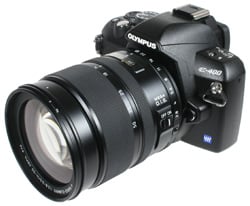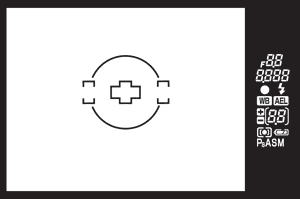Olympus E-400 with Zuiko Digital 14-42mm f3.5-5.6 ED
-
-
Written by Gordon Laing
Olympus E-400 lens coverage
Olympus E-400 features continued…
Lenses and viewfinder / Screen and menus / Sensor and processing / Anti dust
The Olympus E-400 employs a Four Thirds lens mount and is compatible with the complete range of Four Thirds lenses which at the time of writing totalled 19 from Olympus, 11 from Sigma and one from Panasonic / Leica. Like other Four Thirds DSLRs, the E-400’s sensor size effectively reduces the lens field of view by two times, so the Zuiko Digital ED 14-42mm kit lens delivers a 35mm equivalent focal length of 28-84mm. The range of the kit lens in practice is illustrated below.
Olympus E-400 with Zuiko Digital 14-42mm coverage | ||
 |  | |
| 14-42mm at 14mm, f8 (28mm equivalent) | 14-42mm at 42mm, f8 (84mm equivalent) | |
Olympus sells the E-400 as a body alone, or in two different lens kits, one with the ED 14-42mm and the other with both the ED 14-42mm and the ED 40-150mm. You’d be forgiven for assuming these are the same kit lenses bundled with the earlier E-500, but both are in fact brand new models designed to match the compact dimensions of the E-400.
|
Both lenses are much smaller than the E-500’s kit options and employ an ED glass element to correct for colour and other optical aberrations; the ED prefix also helps differentiate them from existing Zuiko Digital models, especially as both new lenses are also sold separately.
To put the differences into perspective, the new ED 14-42mm and older 14-45mm may share the same focal ratio and virtually the same range, but measure 66x61mm and 71x87mm respectively, while weighing 190g and 285g. Clearly the new general purpose lens is much smaller and lighter.
The same applies to the new ED 40-150mm which at f4-5.6 may not be as bright as the existing 40-150mm f3.5-4.5, but again is much smaller and lighter: 66x72mm versus 77x107mm and 220g compared to 425g. Clearly if you’re going for the twin lens kit, that’s quite a saving in size and weight, and as a neat addition, the new models also focus closer than the old ones. See our results pages to compare the new ED 14-42mm with the older 14-45mm kit lens.
It’s also worth mentioning both new lenses feature internal focusing so their end sections don’t rotate. This comes as much relief for users of polarising filters for whom kit lenses like Canon’s EF-S 18-55mm can be quite infuriating. It’s also nice to see Olympus including lens hoods with its kit lenses.
Finally we should mention like all Four Thirds bodies, the manual focusing on the E-400 is motor-assisted. This can feel quite odd if you’re used to traditional mechanical systems and also has quirks like not being adjustable unless the camera’s switched on, not to mention resetting itself to infinity when the power’s switched off (although thankfully it remains unchanged during power-save). If manual focusing is very important to you, we’d advise trying out a Four Thirds body first before buying as you may not get on with the implementation. That said, it’s perfectly possible to manually focus easily and accurately with the E-400.
 | |
We still had the Panasonic L1 on loan when testing the E-400 so couldn’t resist trying the new Olympus body with the Leica 14-50mm lens. As a standard Four Thirds lens, the Leica 14-50mm worked perfectly with the E-400, although with two limitations previously explained by Panasonic: first the aperture ring isn’t currently supported by any body other than the L1, so you’ll need to turn it to A and adjust the aperture electronically like other lenses, and secondly, only the full-time OIS Mode 1 stabilisation is supported.
It’s interesting to use the Leica 14-50mm on the E-400 as it’s currently the only Four Thirds lens with optical stabilisation. As demonstrated in our new Leica D 14-50mm review, the stabilisation is also very effective in practice. Admittedly this particular lens dwarfs the E-400 as seen in the photo, but it remains an interesting option for all E-Series DSLR owners. We’ve included technical results for both the ED 14-42mm and Leica 14-50mm lenses later in this review.
Olympus
E-400 viewfinder
Like other entry-level DSLRs, the E-400 employs a Penta-mirror optical viewfinder, for which Olympus quotes 95% coverage and 0.92x magnification with a 50mm lens set to infinity.
 | |
We’ve found many previous Four Thirds DSLRs have suffered from small and dark viewfinders, but the E-400’s appears relatively large and bright in comparison. Don’t get us wrong, it’s nowhere near same level as the Nikon D80 or D200, but it does deliver a similar height to the Canon 400D / XTi, albeit with a narrower frame due to the 4:3 aspect ratio. Compared with the Panasonic L1 or Olympus E-330 though it’s like chalk and cheese. Due to the necessary optical paths to support Live View, these models have a much smaller and dimmer viewfinder experience that’s not dissimilar to peering down a tunnel. Thankfully that’s not the case with the E-400.
The ‘spare’ space to the right side of the E-400’s viewfinder frame is used to display shooting information consisting of the aperture, shutter, exposure mode, metering mode, exposure compensation (expressed numerically up to +/-5EV), and a battery icon. You won’t find the ISO displayed in the viewfinder, but it is shown on the main screen at all times.




